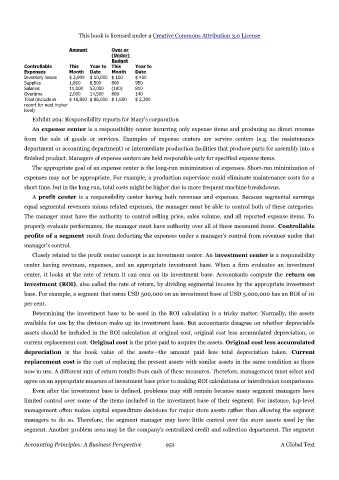Page 950 - Accounting Principles (A Business Perspective)
P. 950
This book is licensed under a Creative Commons Attribution 3.0 License
Amount Over or
(Under)
Budget
Controllable This Year to This Year to
Expenses Month Date Month Date
Inventory losses $ 2,000 $ 10,000 $ 100 $ 400
Supplies 1,800 8,500 800 950
Salaries 11,000 53,000 (100) 810
Overtime 2,000 14,500 800 140
Total (include in $ 16,800 $ 86,000 $ 1,600 $ 2,300
report for next higher
level)
Exhibit 204: Responsibility reports for Macy's corporation
An expense center is a responsibility center incurring only expense items and producing no direct revenue
from the sale of goods or services. Examples of expense centers are service centers (e.g. the maintenance
department or accounting department) or intermediate production facilities that produce parts for assembly into a
finished product. Managers of expense centers are held responsible only for specified expense items.
The appropriate goal of an expense center is the long-run minimization of expenses. Short-run minimization of
expenses may not be appropriate. For example, a production supervisor could eliminate maintenance costs for a
short time, but in the long run, total costs might be higher due to more frequent machine breakdowns.
A profit center is a responsibility center having both revenues and expenses. Because segmental earnings
equal segmental revenues minus related expenses, the manager must be able to control both of these categories.
The manager must have the authority to control selling price, sales volume, and all reported expense items. To
properly evaluate performance, the manager must have authority over all of these measured items. Controllable
profits of a segment result from deducting the expenses under a manager's control from revenues under that
manager's control.
Closely related to the profit center concept is an investment center. An investment center is a responsibility
center having revenues, expenses, and an appropriate investment base. When a firm evaluates an investment
center, it looks at the rate of return it can earn on its investment base. Accountants compute the return on
investment (ROI), also called the rate of return, by dividing segmental income by the appropriate investment
base. For example, a segment that earns USD 500,000 on an investment base of USD 5,000,000 has an ROI of 10
per cent.
Determining the investment base to be used in the ROI calculation is a tricky matter. Normally, the assets
available for use by the division make up its investment base. But accountants disagree on whether depreciable
assets should be included in the ROI calculation at original cost, original cost less accumulated depreciation, or
current replacement cost. Original cost is the price paid to acquire the assets. Original cost less accumulated
depreciation is the book value of the assets—the amount paid less total depreciation taken. Current
replacement cost is the cost of replacing the present assets with similar assets in the same condition as those
now in use. A different rate of return results from each of these measures. Therefore, management must select and
agree on an appropriate measure of investment base prior to making ROI calculations or interdivision comparisons.
Even after the investment base is defined, problems may still remain because many segment managers have
limited control over some of the items included in the investment base of their segment. For instance, top-level
management often makes capital expenditure decisions for major store assets rather than allowing the segment
managers to do so. Therefore, the segment manager may have little control over the store assets used by the
segment. Another problem area may be the company's centralized credit and collection department. The segment
Accounting Principles: A Business Perspective 951 A Global Text

